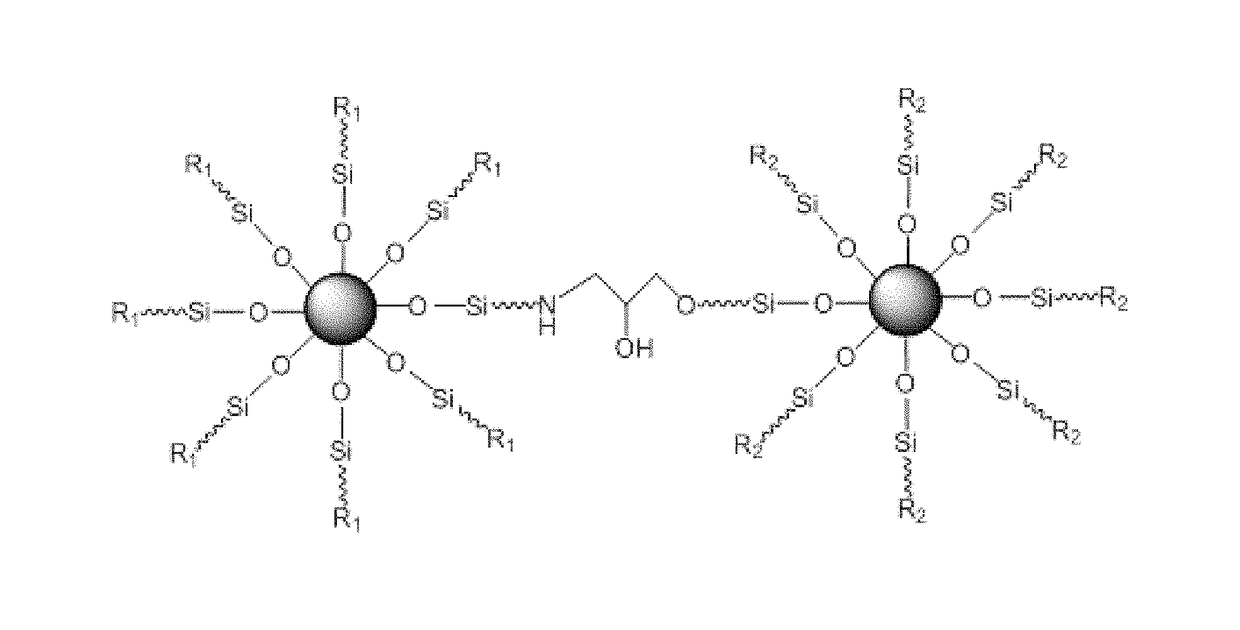Nano-Silica Dispersion Having Amphiphilic Properties And A Double-Particle Structure And Its Production Method
a technology of nano-silica and amphiphilic properties, applied in the direction of silica compounds, mixing, transportation and packaging, etc., can solve the problems of limiting the adjustment of hydrophilic and lipophilic properties of amphiphilic nano-silica, high cost and high cost of production methods, etc., to achieve the effect of simple production method, large specific surface area and low cos
- Summary
- Abstract
- Description
- Claims
- Application Information
AI Technical Summary
Benefits of technology
Problems solved by technology
Method used
Image
Examples
example 1
[0039]This example provides a nano-silica dispersion having amphiphilic properties and a double-particle structure produced by the following steps:
[0040]Step 1: 100 g of silica-ethanol sol with a concentration of 3 wt % was added to a glass reagent bottle at a controlled temperature of 30° C., and 3 g of methylphenyldimethoxysilane was added in terms of 100% by mass of nano-silica, stirred at 30° C. for 2 h and aged at 30° C. for 3 d, to obtain a lipophilically modified silica-ethanol sol having a particle size of 18 nm;
[0041]Step 2: 100 g of silica-ethanol sol with a concentration of 3 wt % was added to a glass reagent bottle at a controlled temperature of 30° C., and 3 g of γ-glycidyl oxypropyltrimethoxysilane was added in terms of 100% by mass of nano-silica, stirred at 30° C. for 2 h and aged at 30° C. for 3 d, to obtain a hydrophilically modified silica-ethanol sol having a particle size of 15 nm;
[0042]Step 3: 150 μg of 3-aminopropyltriethoxysilane was added (at a mass ratio of...
example 2
[0044]This example provides a nano-silica dispersion having amphiphilic properties and a double-particle structure produced by the following steps:
[0045]Step 1: 100 g of silica-ethanol sol with a concentration of 10 wt % was added to a glass reagent bottle at a controlled temperature of 45° C., and 10 g of cetyltrimethoxysilane was added in terms of 100% by mass of nano-silica, stirred at 45° C. for 5 h and aged for 7 d, to obtain a lipophilically modified silica sol having a particle size of 47 nm;
[0046]Step 2: 100 g of silica-ethanol sol with a concentration of 10 wt % was added to a glass reagent bottle at a controlled temperature of 45° C., and 10 g of γ-glycidyl oxypropyltrimethoxysilane was added in terms of 100% by mass of nano-silica, stirred at 45° C. for 5 h and aged at 45° C. for 7 d, to obtain a hydrophilically modified silica sol having a particle size of 55 nm;
[0047]Step 3: 200 μg of 3-aminopropyltriethoxysilane was added (at a mass ratio of 1:50000 to nano-silica in S...
example 3
[0048]This example provides a nano-silica dispersion having amphiphilic properties and a double-particle structure produced by the following steps:
[0049]Step 1: 100 g of silica-ethanol sol with a concentration of 10 wt % was added to a glass reagent bottle at a controlled temperature of 40° C., and 5 g of diphenyldimethoxysilane was added in terms of 50% by mass of nano-silica, stirred at 40° C. for 3 h and aged at 40° C. for 5 d, to obtain a lipophilically modified silica sol having a particle size of 38 nm;
[0050]Step 2: 100 g of silica-ethanol sol with a concentration of 10 wt % was added to a glass reagent bottle at a controlled temperature of 40° C., and 5 g of γ-glycidyl oxypropyltrimethoxysilane was added in terms of 50% by mass of nano-silica, stirred at 40° C. for 3 h and aged at 40° C. for 5 d, to obtain a hydrophilically modified silica sol having a particle size of 47 nm;
[0051]Step 3: 250 μg of 3-aminopropyltriethoxysilane was added (at a mass ratio of 1:40000 to nano-sil...
PUM
| Property | Measurement | Unit |
|---|---|---|
| mass ratio | aaaaa | aaaaa |
| particle size | aaaaa | aaaaa |
| particle size | aaaaa | aaaaa |
Abstract
Description
Claims
Application Information
 Login to View More
Login to View More - R&D
- Intellectual Property
- Life Sciences
- Materials
- Tech Scout
- Unparalleled Data Quality
- Higher Quality Content
- 60% Fewer Hallucinations
Browse by: Latest US Patents, China's latest patents, Technical Efficacy Thesaurus, Application Domain, Technology Topic, Popular Technical Reports.
© 2025 PatSnap. All rights reserved.Legal|Privacy policy|Modern Slavery Act Transparency Statement|Sitemap|About US| Contact US: help@patsnap.com

